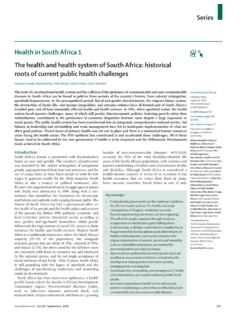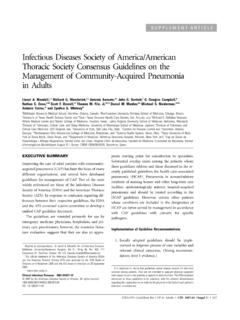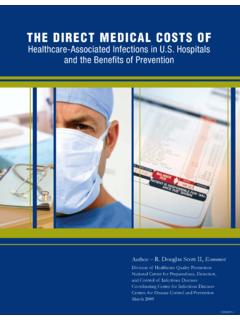Transcription of Best Practices for Environmental Cleaning in Healthcare ...
1 CS314156-ABest Practices for Environmental Cleaning in Healthcare Facilities: in Resource-Limited SettingsDivision of Healthcare Quality PromotionVERSION 2ii | Best Practices for Environmental Cleaning in Healthcare Facilities in Resource-Limited SettingsCS295875-AThis document provides guidance on best Practices for Environmental Cleaning procedures and programs in Healthcare facilities in resource-limited settings. It was developed as a collaboration between the Centers for disease Control and Prevention (CDC) and the Infection Control Africa Network (ICAN). Best Practices for Environmental Cleaning in Healthcare Facilities in Resource-Limited Settings is a publication of the Division of Healthcare Quality Promotion in the National Center for Emerging and Zoonotic infectious Diseases within CDC and the Education Working Group of the Infection Control Africa Network.
2 Centers for disease Control and PreventionRobert Redfield, MD, DirectorNational Center for Emerging and Zoonotic infectious DiseasesRima Khabbaz, MD, DirectorDivision of Healthcare Quality Promotion Denise Cardo, MD, Director Infection Control Africa NetworkSade Ogunsola, PhD, ChairEducation Working Group Shaheen Mehtar, MBBS, Chair (Past Chair ICAN)Photo Credit:Cover page photo features Ms. De Bruin, a dedicated and passionate Environmental Cleaning staff member for over 40 years at a hospital in Cape Town, South Africa. Suggested citation:CDC and ICAN. Best Practices for Environmental Cleaning in Healthcare Facilities in Resource-Limited Settings.
3 Atlanta, GA: US Department of Health and Human Services, CDC; Cape Town, South Africa: Infection Control Africa Network; 2019. Available at: and Practices for Environmental Cleaning in Healthcare Facilities in Resource-Limited Settings | iiiAcknowledgements Overall coordination and writing of the best Practices : Molly Patrick (International Infection Control Program, Division of Healthcare Quality Promotion, CDC, Atlanta, Georgia, USA) jointly coordinated the development and led the writing of the best Practices . Shaheen Mehtar (Education Working Group, Infection Control Africa Network, Cape Town, South Africa) jointly coordinated the development and contributed significantly to the structure and content of the best Practices .
4 Danielle Carter, Joyce Thomas and Sonya Arundar (Division of Healthcare Quality Promotion, CDC) provided professional editing (plain language and usability) assistance. Expert Committee: The following experts participated in technical consultations to guide the development and provided technical review of the best Practices : Benedetta Allegranzi, Nathalie Tremblay (Department of Service Delivery and Safety, World Health Organization (WHO), Switzerland); Margaret Montgomery (Water, Sanitation, Hygiene and Health unit , WHO, Switzerland); Claire Kilpatrick (Soapbox Collaborative, UK); Joost Hopman (Consultant Microbiologist, Radboud University Medical Center, The Netherlands); Nkwan Jacob Gobte (Infection Control Africa Network, Cameroon).
5 Matt Arduino, Michael Bell, Bryan Christensen, Denise Kirley, Cliff McDonald, Sujan Reddy, Rachel Smith, Amy Valderrama (Division of Healthcare Quality Promotion, CDC). External Peer Review Group: The following experts provided technical expertise on infection prevention and control (IPC) in resource-limited settings: Nizam Damani (IPC Consultant, WHO and Southern Health & Social Care Trust, UK); Briette du Toit (Infection Prevention and Control Officer, Mediclinic Southern Africa, South Africa); Nagwa Khamis (CEO Consultant and Head of IPC Department, Children Cancer Hospital of Egypt, Egypt); Linus Kirimi Ndegwa (Program Manager, IPC/AMR, Division of Global Health Protection, CDC and IPNET-K Secretary General, Kenya).
6 Robert M Njee (Senior Research Scientist, National Institute for Medical Research, Tanzania); Marcelyn Magwenzi (Microbiologist/IPC Trainer, Infection Control Association of Zimbabwe, Zimbabwe); Ana Maruta (IPC Team Lead, WHO, Sierra Leone); Apurba S Sastry (Infection Control Officer, Antimicrobial Stewardship Lead, Associate Professor of Microbiology, Jawaharlal Institute of Postgraduate Medical Education and Research, India); Yolanda Van Zyl (Infection Control Practitioner/Chairperson Infection Control Society South Africa, Paarl Hospital, Western Capt Department of Health, South Africa).
7 TABLE OF CONTENTSA cknowledgements ..iiiAbbreviations ..viiiKey definitions ..1 Icon introduction .. Environmental transmission of HAIs .. Environmental Cleaning and IPC .. Environmental Cleaning and WASH infrastructure .. Basis and evidence for proposed best Practices .. Purpose and scope of the document .. Intended audience of the document .. Overview of the document ..92. Cleaning Programs .. Organizational elements .. Administrative support .. Communication .. Management and supervision .. Staffing Staffing levels.
8 Training and Supporting infrastructure and supply elements .. Designated space .. Water and wastewater services .. Supplies and equipment procurement and management .. Finishes, furnishings and other considerations .. Policies and procedural elements .. Cleaning policies .. Standard operating procedure .. Cleaning checklists, logs, and job aids ..22vi | Best Practices for Environmental Cleaning in Healthcare Facilities in Resource-Limited Monitoring, feedback and audit elements .. Routine monitoring .. Feedback mechanisms.
9 Program audits ..263. Environmental Cleaning Supplies and Equipment .. Products for Environmental Cleaning .. Cleaning products .. Disinfectants .. Combined detergent-disinfectants .. Preparation of Environmental Cleaning products .. Supplies and equipment for Environmental Cleaning .. Preparation of supplies and equipment .. Personal protective equipment for Environmental Cleaning .. Care and storage of supplies, equipment, and personal protective equipment ..374. Environmental Cleaning Procedures .. General Environmental Cleaning techniques.
10 General patient areas .. Outpatient wards .. Routine Cleaning of inpatient wards .. Terminal or discharge Cleaning of inpatient wards .. Scheduled Cleaning .. Patient area toilets .. Patient area floors .. Spills of blood or body fluids .. Specialized patient areas .. Operating rooms .. Medication preparation areas .. Sterile service departments (SSD) .. Intensive care units .. Emergency departments ..54 Best Practices for Environmental Cleaning in Healthcare Facilities in Resource-Limited Settings | Monitoring, feedback and audit elements.













